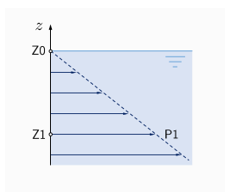PLOADSF
Bulk Data Entry Parameters of pressure loads on a surface defined by a SURF Bulk Data Entry or SET Bulk Data Entry.
The SURF format of type ELFACE and the SURF/SET format of type ELEM are supported.
Format A
| (1) | (2) | (3) | (4) | (5) | (6) | (7) | (8) | (9) | (10) |
|---|---|---|---|---|---|---|---|---|---|
| PLOADSF | SID | ELSET/SURF | Type | P |
Format B
| (1) | (2) | (3) | (4) | (5) | (6) | (7) | (8) | (9) | (10) |
|---|---|---|---|---|---|---|---|---|---|
| PLOADSF | SID | ELSET/SURF | Type | P1 | CID | Z0 | Z1 |
Format C
| (1) | (2) | (3) | (4) | (5) | (6) | (7) | (8) | (9) | (10) |
|---|---|---|---|---|---|---|---|---|---|
| PLOADSF | SID | ELSET/SURF | Type | P | CID | N1 | N2 | N3 |
Definitions
| Field | Contents | SI Unit Example |
|---|---|---|
| SID | Load set
identification number. No default (Integer > 0) |
|
| ELSET/SURF | Surface
identification. The following surface definition options are
supported:
No default (Integer > 0 or <String>) |
|
| Type | Pressure type
applied.
(Character) |
|
| P | Constant pressure
magnitude. No default (Real) |
|
| P1 | Hydrostatic pressure
magnitude at Z1. 4 No default (Real) |
|
| CID | Coordinate system
identification number.
Default = 0 (Integer > 0, or blank) |
|
| ZO | Z-coordinates of the
zero-pressure level, in the user-defined coordinate system.
3 No default (Real) |
|
| Z1 | Z-coordinates of the
level at which the hydrostatic pressure P1 is defined, in the user-defined coordinate system. 3
4 No default (Real) |
|
| N1, N2, N3 | Components of a vector
measured in the user-defined coordinate system. The vector is
normalised internally such that it does not contribute to the
magnitude of the load. For Type DIREC, the vector defines the direction of the load. For Type SHEAR, the projection of the vector on local element surfaces gives the direction of the shear traction. If the vector is perpendicular to the face of an element, the corresponding shear pressure will be set to 0. Default = 0 (Real) |
Comments
- The magnitude of surface tractions of types NORMAL, DIREC and SHEAR is assumed be constant.
- The direction for surface tractions of types NORMAL and HYDRO is consistent with the normal direction of the referenced surface.
- If Type = HYDRO, if the basic coordinate system is used in axisymmetric analysis defined in xz- and xy- planes, Z0 and Z1 specify values of the z- and y-coordinate, respectively.
- If Type =
HYDRO, the magnitude of the hydrostatic pressure,
varies linearly between Z0 and Z1 and
vanishes above Z0 (Figure 1). As Z0 is the
zero-pressure level and Z1 is the level at which P1 is defined, Z0 must be greater than
Z1 (Z0 > Z1),
else OptiStruct will error out.
Figure 1. Definition of the Hydrostatic Pressure 
- Only the complete follower option, for example, FLLWER = 1, is provided for the hydrostatic pressure of type HYDRO, and other options (FLLWER = 2 and 3) will be converted internally, if specified. For types NORMAL, DIREC and SHEAR, all the follower options are supported.
- String based labels allow for easier visual identification, including when being referenced by other entries. For more details, refer to String Label Based Input File.